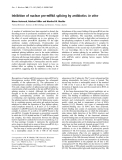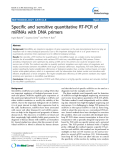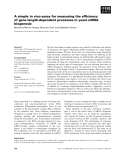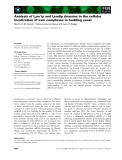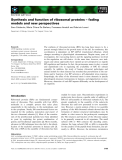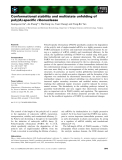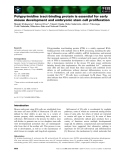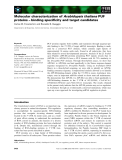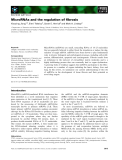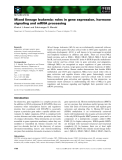
Mrna processing
-
A number of antibiotics have been reported to disturb the decoding process in prokaryotic translation and to inhibit the function of various natural ribozymes. We investigated the eect of several antibiotics on in vitro splicing of a eukaryotic nuclear pre-mRNA (b-globin). Of the eight antibiotics studied, erythromycin, Cl-tetracycline and streptomycinwere identi®ed as splicing inhibitors in nuclear HeLa cell extract. TheKi values were 160, 180 and 230lM, respectively.
 9p
9p  research12
research12
 29-04-2013
29-04-2013
 31
31
 3
3
 Download
Download
-
important regulators of biological processes in animals and plants. MiRNAs regulate gene expression at the posttranscriptional level by binding to mRNAs and either inhibit translation or modify the stability of the mRNA. Due to the important biological role of miRNAs it is of great interest to study their expression level in the cells. Furthermore, miRNAs have been associated with cancer and other diseases [1] and miRNA expression can help in the diagnosis and prognostic of human disease [2,3].
 11p
11p  zingzing09
zingzing09
 24-04-2013
24-04-2013
 52
52
 3
3
 Download
Download
-
We have developed a simple reporter assay useful for detection and analysis of mutations and agents influencing mRNA biogenesis in a gene length-dependent manner. We have shown that two transcription units sharing the same promoter, terminator and open reading frame, but differing in the length of their 3¢-untranslated regions, are differentially influenced by muta-
 14p
14p  dell39
dell39
 27-03-2013
27-03-2013
 34
34
 3
3
 Download
Download
-
In eukaryotes, two heteroheptameric Sm-like (Lsm) complexes that differ by a single subunit localize to different cellular compartments and have dis-tinct functions in RNA metabolism. The cytoplasmic Lsm1–7p complex promotes mRNA decapping and localizes to processing bodies, whereas the Lsm2–8p complex takes part in a variety of nuclear RNA processing events.
 16p
16p  vinaphone15
vinaphone15
 25-02-2013
25-02-2013
 41
41
 2
2
 Download
Download
-
The synthesis of ribosomal proteins (RPs) has long been known to be a process strongly linked to the growth status of the cell. In vertebrates, this coordination is dependent on RP mRNA translational efficiency, which changes according to physiological circumstances.
 12p
12p  viettel02
viettel02
 22-02-2013
22-02-2013
 35
35
 2
2
 Download
Download
-
Poly(A)-specific ribonuclease (PARN) specifically catalyzes the degradation of the poly(A) tails of single-stranded mRNAs in a highly processive mode. PARN participates in diverse and important intracellular processes by act-ing as a regulator of mRNA stability and translational efficiency. In this article, the equilibrium unfolding of PARN was studied using both guani-dine hydrochloride and urea as chemical denaturants.
 12p
12p  viettel02
viettel02
 22-02-2013
22-02-2013
 42
42
 4
4
 Download
Download
-
Polypyrimidine tract-binding protein (PTB) is a widely expressed RNA-binding protein with multiple roles in RNA processing, including the splic-ing of alternative exons, mRNA stability, mRNA localization, and internal ribosome entry site-dependent translation. Although it has been reported that increased expression of PTB is correlated with cancer cell growth, the role of PTB in mammalian development is still unclear.
 11p
11p  viettel02
viettel02
 20-02-2013
20-02-2013
 35
35
 3
3
 Download
Download
-
PUF proteins regulate both stability and translation through sequence-spe-cific binding to the 3¢ UTR of target mRNA transcripts. Binding is medi-ated by a conserved PUF domain, which contains eight repeats of approximately 36 amino acids each. Found in all eukaryotes, they have been related to several developmental processes.
 15p
15p  viettel02
viettel02
 20-02-2013
20-02-2013
 32
32
 2
2
 Download
Download
-
The RNA degradosome is built on the C-terminal half of ribonuclease E (RNase E) which shows high sequence variation, even amongst closely related species. This is intriguing given its central role in RNA processing and mRNA decay. Previously, we have identified RhlB (ATP-dependent DEAD-box RNA helicase)-binding
 13p
13p  viettel02
viettel02
 19-02-2013
19-02-2013
 27
27
 1
1
 Download
Download
-
In trypanosomatids, the regulation of gene expression occurs mainly at the post-transcriptional level. Previous studies have revealed nontranslated mRNA in theTrypanosoma cruzicytoplasm. Previously, we have identified and cloned the TcDHH1 protein, a DEAD box RNA helicase. It has been reported that Dhh1 is involved in multiple RNA-related processes in vari-ous eukaryotes.
 12p
12p  viettel02
viettel02
 19-02-2013
19-02-2013
 38
38
 3
3
 Download
Download
-
MicroRNAs (miRNAs) are small, noncoding RNAs of 18–25 nucleotides that are generally believed to either block the translation or induce the deg-radation of target mRNA. miRNAs have been shown to play fundamental roles in diverse biological and pathological processes, including cell prolif-eration, differentiation, apoptosis and carcinogenesis.
 7p
7p  mobifone23
mobifone23
 21-01-2013
21-01-2013
 41
41
 5
5
 Download
Download
-
Mixed lineage leukemias(MLLs) are an evolutionarily conserved trithorax family of human genes that play critical roles in HOXgene regulation and embryonic development.MLL1is well known to be rearranged in myeloid and lymphoid leukemias in children and adults. There are several MLL family proteins such as MLL1, MLL2, MLL3, MLL4, MLL5, Set1A and Set1B, and each possesses histone H3 lysine 4 (H3K4)-specific methyltrans-ferase activity and has critical roles in gene activation and epigenetics.
 15p
15p  mobifone23
mobifone23
 21-01-2013
21-01-2013
 47
47
 4
4
 Download
Download
CHỦ ĐỀ BẠN MUỐN TÌM









